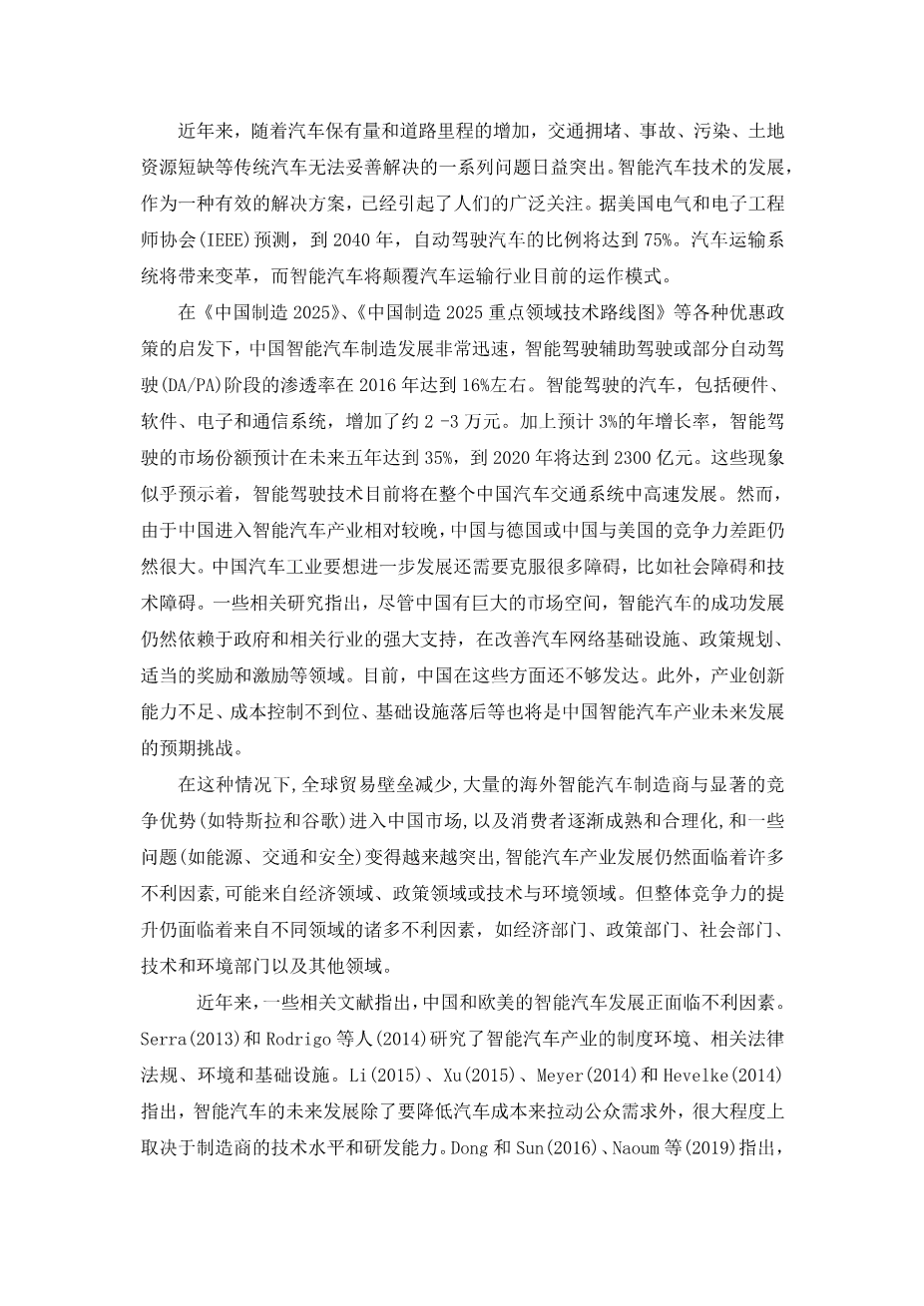In recent years, with the increasement of car ownership and road mileage, a series of problems that cannot be properly solved by traditional cars are increasingly prominent such as traffic congestion, accidents, pollution and land resource shortage. The development of intelligent vehicle technology, which is regarded as an effective solution, has attracted much attention. American Institute of Electrical and Electronics Engineers (IEEE) predicts that the proportion of automatic driving vehicles will reach 75 percent by 2040. The automobile transportation system will usher in changes, and the intelligent automobile may subvert the current operation mode of automobile transportation industry.
Inspired by a variety of preferential policies, such as Chinarsquo;s manufacturing 2025 and Chinarsquo;s manufacturing 2025-technical road map in key areas, China rsquo;s intelligent automobile manufacturing had a very rapid development, and the permeability of intelligent driving assisted driving or partial autonomous driving (DA/PA) stage achieved about 16 per cent 2016.The cost of each automobile, which is driven by intelligent driving, including hardware, software, electronics and communications system, increased about 20000-30000 Yuan. Combined with the expected annual growth rate of 3 per cent, intelligent driving market share is expected to achieve 35 percent in the next five years, and it will exceed 230bnYuan in 2020. All these phenomena seem to indicate that intelligent driving is about to develop at high speed at present in the entire Chinese automotive transportation system. However, because Chinarsquo;s involvement in intelligent automobile industry is relatively late, the gap between the competitiveness of China and Germany or China and the USA is still large. Chinarsquo;s auto industry still has to overcome many obstacles if they want to get further development, such as social obstacles and technical obstacles. Some related studies pointed out that although China have a huge market space, the successful development of intelligent vehicle still depends on the strong support by government and related industries, in the areas of improving car networking infrastructure ahead, policy planning, appropriate rewards and incentives, etc. Currently, China is not sufficiently developed in these areas. In addition, the lack of industrial innovation capacity, inadequate cost control and backwardness of the infrastructure also are the expected challenges for the future development of Chinese intelligent automotive industry. Under the circumstances that the global trade barriers are reduced, a large number of overseas intelligent automobile manufacturers with significant competitive advantages (such as Tesla and Google) enter Chinese market, as well as consumers have gradually matured and rationalized, and some issues (like energy, transportation and safety) have become increasingly prominent, smart car industry development still faces many unfavorable factors, which may come from the economic field or policy field or technology and environmental field (Shang, 2017; Xu, 2016; Wong and Lee, 2014; Wu, 2009). But the upgrading of overall competitiveness still faces many unfavorable factors that emerge from different fields, such as economic sector, policy sector, social sector, technical and environmental sector and others fields.
In recent years, some related literature has noted that the development of intelligent vehicles in China and Europe and the USA is facing unfavorable factors. Serra (2013) and Rodrigo et al. (2014) have examined the institutional environment, relevant laws and regulations, environment and infrastructure of the intelligent automobile industry. Li(2015), Xu(2015), Meyer (2014) and Hevelke (2014) pointed out that, in addition to reducing vehicle costs to boost public demand, the future development of intelligent automobile largely depends on manufacturerrsquo;s technical level and Ramp;D capability. Dong and Sun (2016) and Naoum et al. (2019) pointed out that the realization of intelligent manufacturing needs related industries in industry chain to achieve the same production level. Yao et al. (2014) pointed out that the intelligent manufacturing capacity and level of relevant industries in Chinas automobile manufacturing industry chain are generally low. Without cross-industry cooperation (cooperation of parts manufacturers, network operators, platform operators, content providers, service providers, and transportation management departments), it may not be possible to realize the transfer of intelligent automobile technological innovation achievements and industrialization. Xu (2015) proposed that the development and popularization of intelligent automobile not only need the integration of intelligent automobile industry itself, but also need cross-industry and cross-sectoral integration, and hence merging the elements in technical chain and industrial chain is the basis for sustainable development of intelligent automobile industry and the key point to enhance the overall competitiveness of Chinarsquo;s intelligent automobile industry. Alam and Saini (2015) believe that rigorous testing standards and procedures are indispensable to ensure the reliability of intelligent technology. Zhang and Li (2009) pointed out that to enhance intelligent automobile penetration rate, manufacturers should think from the perspective of market consumers, that is, in addition to economic factors, security and comfort, other factors need to be considered either. Qi (2019) proposes that technical safety is the most important factor that people should consider. Based on the research of Etzion (2007) and Cachon and Kok (2010), Xu (2015) divides the hinder factors of intelligent automobile penetration into four categories: technical constraints (such as lack of safety and a well-established navigation database), infrastructure constraints (such as lack of human–car– road interconnection and information intelligent roads),busine
剩余内容已隐藏,支付完成后下载完整资料

英语译文共 11 页,剩余内容已隐藏,支付完成后下载完整资料
资料编号:[258952],资料为PDF文档或Word文档,PDF文档可免费转换为Word


